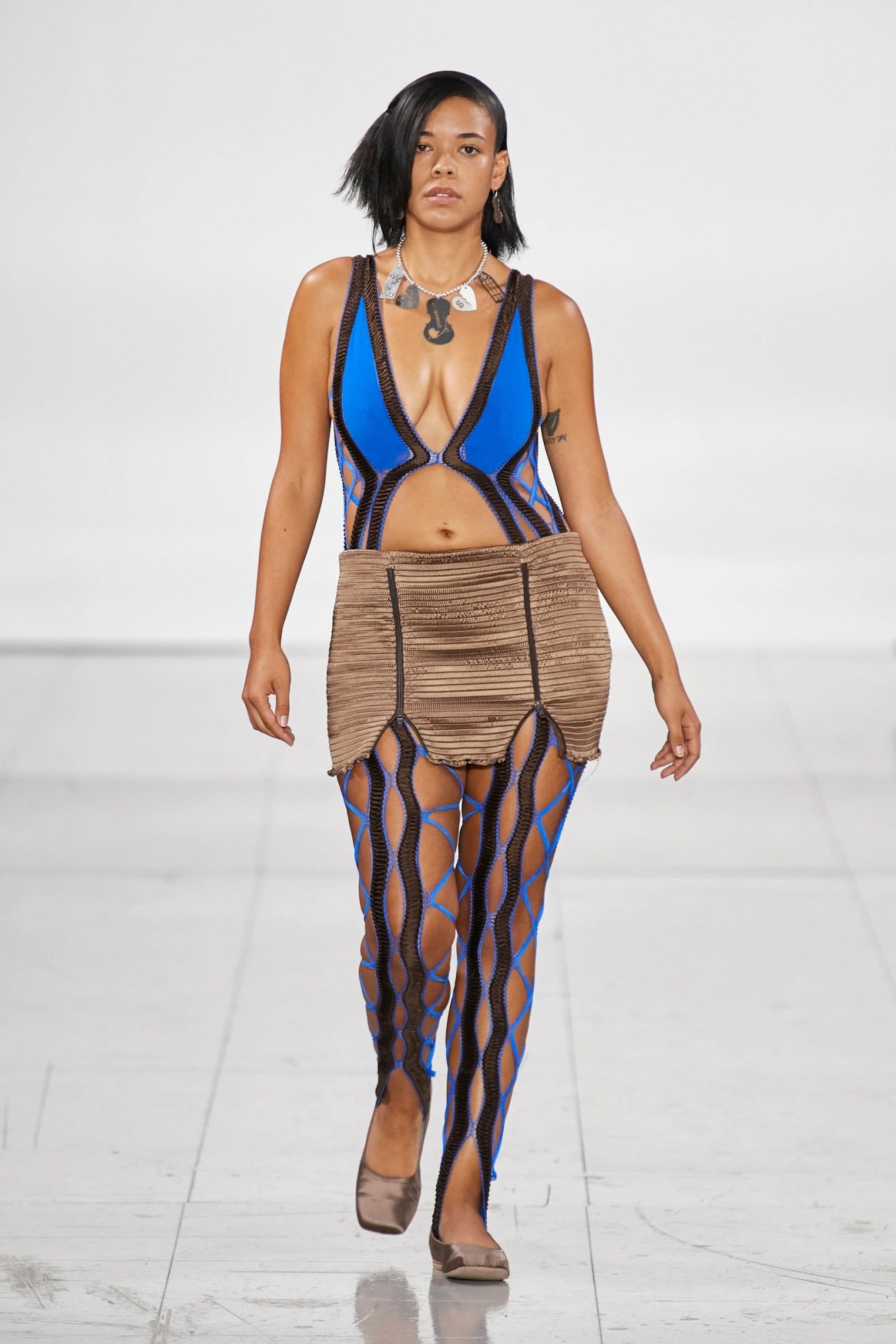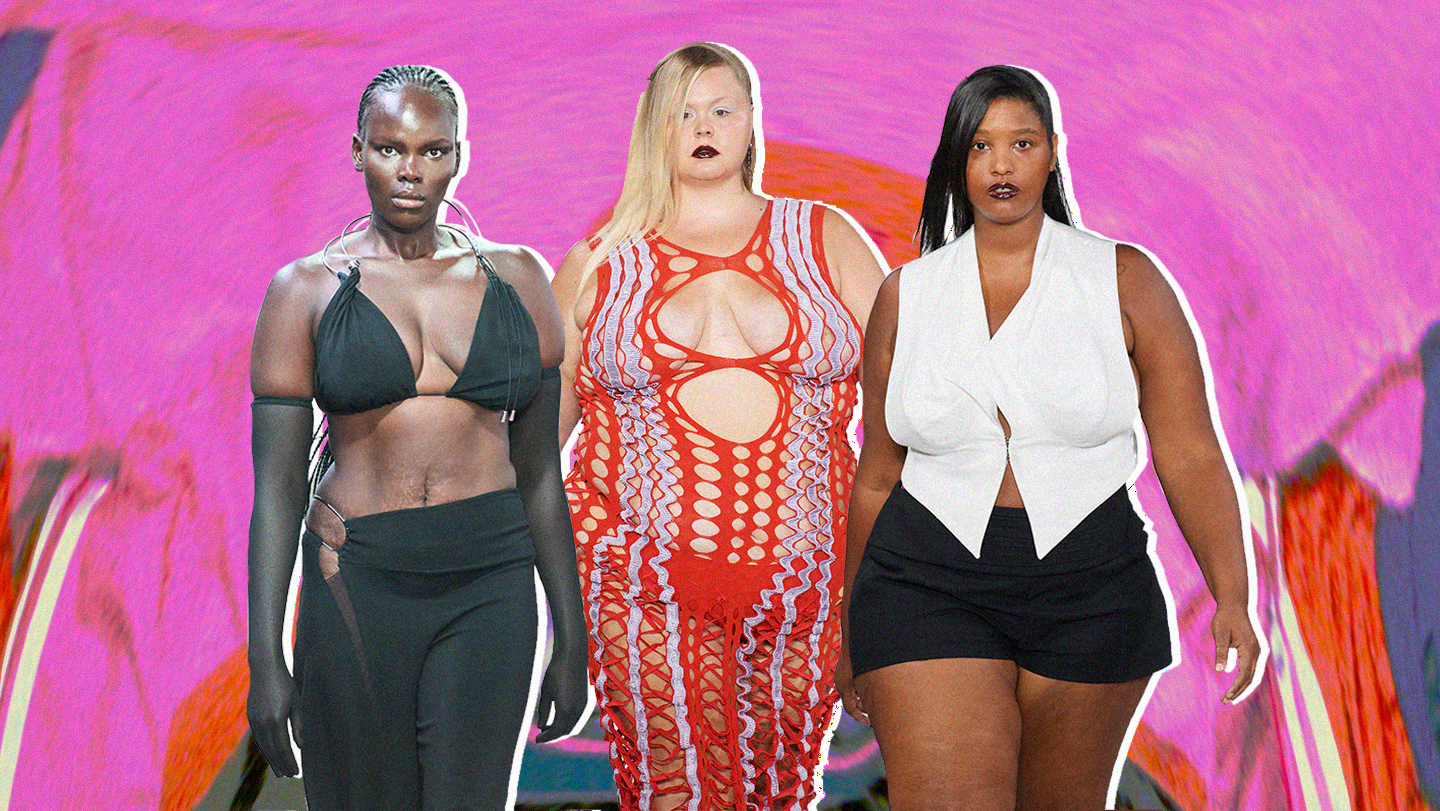An excuse that often rears its head when it comes to size inclusivity on the catwalk is that it’s simply more ‘practical’ to use sample size models – people who fit a standardised set of measurements used for collections across the board. But in 2022, where representation, inclusivity and accountability are paramount, a narrow one-size-fits-all approach just isn’t enough. Catwalks are no longer just one-dimensional sales events, and the models that walk them are more than mere mannequins. As the gap between the fashion industry and the rest of the world slowly closes, one thing that’s becoming increasingly certain is this: fashion shows are not just about the clothes.
Though London’s fashion industry is arguably the least financially lucrative among the Big Four fashion capitals – and the fact that those on the London Fashion Week SS23 schedule had to deal with the added hiccup of the Queen’s funeral – boy, did the city’s independent designers prevail when it came to size inclusivity on the catwalk. A testament to how far we’ve come since a time when the only plus-size model seen was Ashley Graham, at shows such as Karoline Vitto, Sinéad O’Dwyer, Di Petsa and Chopova Lowena, non-sample size models made up at least half, if not all, of the casting, marking a significant step in the right direction for genuine representation for seasons to come.

While there has, of course, been an increase in body-inclusive casting at fashion weeks worldwide, there was something to what we saw in London this season that felt especially progressive. Sinéad O’Dwyer, who staged her catwalk debut – a celebration of bodies of different sizes, physical abilities and gender identities – on Tuesday, thinks that the reason the city’s designers are leading the charge when it comes to size and body diversity is London’s status as “a very open city with a big queer community,” she says. “Being accepting of people as they come is more common in the fashion community here than in others, perhaps.”
When asked why having a diverse range of bodies on the catwalk remains a topic of conversation in 2022, Sinéad cites the practical and financial hurdles which often prevent emerging designers from carrying out their true vision. “It’s very difficult for designers to have a wide range of sizes if they have a limited budget,” she says. “You can’t just make everything bigger when it comes to grading; bodies vary dramatically in shape and proportion, so there is no easy way to grade up from a size 8 to a size 20, for example. It’s also more difficult to work from numerous block patterns at once, and to use a range of fit models.”
And yet, despite these complexities, the designer still chooses to work with a size 18/20 fit model, integrating size-inclusivity into her design process from the very start. “Luxury fashion has always excluded the majority of people, which has a huge impact on mental health,” she says. “Seeing many different bodies on a catwalk will hopefully make more people feel a part of luxury fashion, and like they’re being properly considered. Being represented is one of the most important things especially when you are young, and those experiences are formative.”

These were sentiments felt by the models who walked the show. “A few of them told me that they never get the opportunity to wear the sort of clothes that I make or other luxury garments as they are not made in their size,” Sinéad says. Emma Mattell, the show’s casting director, recognises that too: “Everyone gets dressed and needs clothes. Why would you – from a moral, aesthetic and commercial standpoint – exclude your buyers?” .
Another designer who nailed size-inclusivity at London Fashion Week is Brazilian-born Karoline Vitto, whose ready-to-wear sizing goes up to a UK 28, with custom size enquiries also welcomed. This season, the London-based designer presented her first collection as part of Fashion East, a body of work that sought to celebrate the areas of women’s bodies that we often feel self-conscious about.
Cast by Madeleine Østlie, it featured 11 models, ranging from size 12 to 20. Her thoughts on the importance of representative casting mirror Sinéad and Emma’s. “Without representation, things become niche, they become narrow-minded and they become insular. It’s also about representing customers and people who spend money at these brands,” she says. “Why are you going to take people’s money and not represent them in your campaigns and on your catwalks?”

Despite the cost sacrifices that come with making sample sets in larger sizes, designers like Sinéad O’Dwyer and Karoline Vitto have nonetheless integrated non-sample-sized bodies into their design processes and brand aesthetics from the very start. The same, however, cannot be said of the vast majority of luxury fashion brands that operate at significantly greater scales. “At the end of the day, a sample size set is a cost-effective measure and the premise of that cost-effective measure should remain with young designers who can’t afford to do otherwise, not necessarily designers who are supported by a global conglomerate,” Madeleine says. “The pressure should be more on the big houses where they have an infrastructure and an atelier to support a more generous sizing set.”
This is hardly a new conversation, though. In 2020, stylist Francesca Burns posted a picture of a UK size 8 model unsuccessfully fitting into a sample size pair of trousers on Instagram, which eventually went viral. “Here’s a thought for a Saturday morning…can we make our sample sizes bigger please? I never want anyone on my set to be made to feel ‘less than’,” the caption read. “More often than not, I’m working with young women who – in spite of being exceptionally beautiful – are living, breathing, feeling human beings who should never be made to feel they are ‘too big’ for the clothes.”

Fast forward two years and you can bet your bottom dollar that this has happened countless times since. Despite the increased spotlight on the subject, many still fail to realise that it’s not just about casting a bigger model. It’s also about ensuring that they are thoughtfully accommodated – that they aren’t simply draped with a piece of fabric, or asked to pose nude because they’ve “got such a gorgeous body and should “show it off”.
The efforts of Sinéad O’Dwyer and Karoline Vitto show what meaningful representation could and should look like, setting a precedent for the industry at large. By placing these values at the heart of their brands from the outset, their work amounts to so much more than a passing, tokenistic trend. For proof, see the onlookers at their shows brought to tears at having finally seen themselves represented on one of fashion’s most prolific stages, or the outpouring of affinity in the comments section of i-D’s recent TikTok from Sinéad’s show. Moments like these make it crystal clear: it’s time for the industry’s old guard to catch up, and tackle the disparity of body diversity on the catwalks once and for all.

Follow i-D on Instagram and TikTok for more fashion think pieces.

